
Rednal is a residential suburb on the south western edge of metropolitan Birmingham, West Midlands, England, 9 miles southwest of Birmingham city centre and forming part of Longbridge parish and electoral ward. Historically it was part of Worcestershire.

Longbridge is an area in the south-west of Birmingham, England, located near the border with Worcestershire, historically being within it.

Nottingham Corporation Tramways was formed when Nottingham Corporation took over the Nottingham and District Tramways Company Limited, which had operated a horse and steam tram service from 1877.
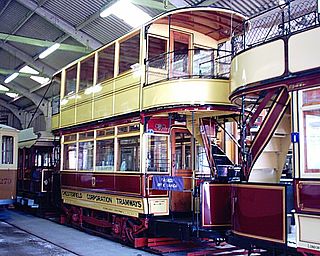
The Chesterfield and District Tramways Company and its successors ran a tramway system in the Derbyshire town of Chesterfield, England. The first horse-drawn line opened in 1882, and in 1897, the system was taken over by Chesterfield Corporation, who extended and electrified it in 1904 and 1905. Additional tramcars were purchased, but two had to be scrapped after a disastrous fire at the depot in 1916. The system suffered from a lack of maintenance as a result of reduced staffing levels during the First World War, and the trams were replaced by trolleybuses in 1927.

The Kingston upon Hull tramway network was a network of 4 ft 8+1⁄2 instandard gauge tram lines following the five main roads radially out of the city centre of Kingston upon Hull, East Riding of Yorkshire, England. Two of these lines went west, and two east. The fifth went to the north, and branched to include extra lines serving suburban areas. Additionally a short line linked the city centre to the Corporation Pier where a ferry crossed the Humber Estuary to New Holland, Lincolnshire.

The Leipziger Verkehrsbetriebe (LVB), literally translated into English as the Leipzig Transport Authority, operates the tramway and bus transport services in Leipzig, Germany. The LVB network is a part of the regional public transport association, the Mitteldeutscher Verkehrsverbund (MDV). The LVB was formed by the merger, from 1 January 1917, of two predecessor undertakings, the Großen Leipziger Straßenbahn and the Leipziger Elektrischen Straßenbahn. The merged undertaking was also known as GLSt until it was reorganized and renamed as the LVB, from 29 July 1938.
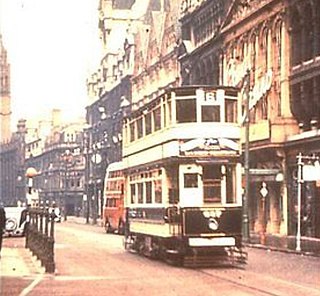
Birmingham Corporation Tramways operated a network of tramways in Birmingham from 1904 until 1953. It was the largest narrow-gauge tramway network in the UK, and was built to a gauge of 3 ft 6 in. It was the fourth largest tramway network in the UK behind London, Glasgow and Manchester.
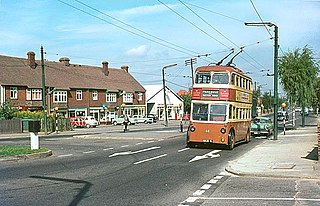
Maidstone Corporation Transport was the operator of trams, trolleybuses and motorbuses in Maidstone, Kent from 1904 to 1974. The operations of Maidstone Corporation passed to Maidstone Borough Council Transport in reorganisation of local government in 1974, expanding the Borough boundaries.
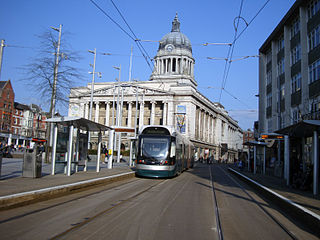
Nottingham is the seventh largest conurbation in the United Kingdom; despite this, the city's transport system was deemed to be poor for its size in the 1980s. In the early twenty-first century, the UK government invested heavily in the transport network of Nottingham, which has led to the re-opening of the Robin Hood Line and the construction of a light rail system, Nottingham Express Transit.

Between 1901 and 1949 Manchester Corporation Tramways was the municipal operator of electric tram services in Manchester, England. At its peak in 1928, the organisation carried 328 million passengers on 953 trams, via 46 routes, along 292 miles (470 km) of track.

The Wolverhampton trolleybus system served the city of Wolverhampton, then in Staffordshire, England, for much of the twentieth century.

The Nottingham trolleybus system once served the city of Nottingham, in the county of Nottinghamshire, England. It opened on 10 April 1927, and gradually replaced the Nottingham tramway network.

The Walsall trolleybus system once served the town of Walsall, then in Staffordshire, but now in West Midlands, England. Opened on 22 July 1931, it gradually replaced the Walsall Corporation Tramways network.

The Grimsby trolleybus system once served the seaport of Grimsby, in Lincolnshire, England. Opened on 3 October 1926, it gradually replaced part of the Great Grimsby Street Tramways, a tramway that had served both Grimsby and the neighbouring holiday resort of Cleethorpes. It was closed on 4 June 1960.

The Cleethorpes trolleybus system once served the holiday resort of Cleethorpes, in Lincolnshire, England. Opened on 18 July 1937, it replaced part of the Great Grimsby Street Tramways, a tramway that had served both Cleethorpes and the neighbouring seaport of Grimsby. It was closed on 4 June 1960.
Southend-on-Sea Corporation Transport was the overarching name given to the local municipal transport services provided to the town of Southend-on-Sea by the local council. Initially started as a tramway, although known officially as Southend-on-Sea Corporation Light Railway, the trams started operating on 19 July 1901 until the service was terminated on 8 April 1942. A trolleybus system was introduced in 16 October 1925, gradually replacing the tramway, before it closed on 28 October 1954. Motorbuses were first run by the Corporation in 1914, but two years later they withdrew the services. Buses did not return to the Corporation's service until 1932, eventually replacing the trams and trolleybuses. In 1974, the organisation was renamed Southend Transport, and after the Transport Act of 1985, it became involved in a bus war with rival Thamesway. The council sold Southend Transport to British Bus group in June 1993, which in turn was taken over by the Cowie group. Cowie was renamed Arriva in August 1998, with Southend Transport becoming Arriva serving Southend.
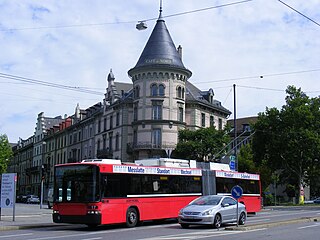
The Bern trolleybus system is part of the public transport network of Bern, the capital city of Switzerland. Opened in 1940, it combines with the Bern S-Bahn, the Bern tramway network and Bern's urban motorbus network to form an integrated all-four style scheme.

Buses in Ipswich operate in the town of Ipswich in the English county of Suffolk. As of 2013 services are primarily operated by Ipswich Buses and First Norfolk & Suffolk, although other smaller operators, such as Galloway European, Carters Coaches and Beestons, operate routes from the town into the surrounding rural area. Many of the current routes are based on those established at the end of the 19th century when a horse tram network developed.

The West Midlands Passenger Transport Executive (WMPTE) was the public body responsible for public transport in the West Midlands metropolitan county in the United Kingdom from 1969 until 2016. The organisation operated under the name Centro from 1990, and was publicly branded as Network West Midlands from 2005.
Bradford Corporation Tramways were a tramway network in the city of Bradford, West Riding of Yorkshire, England which operated trams from 1882 until 1950 and trolleybuses from 1911 until 1972. The track gauge of the tramways was 4 ft.


























